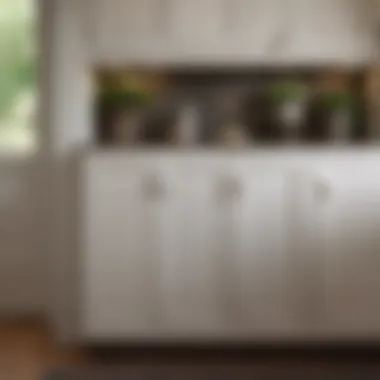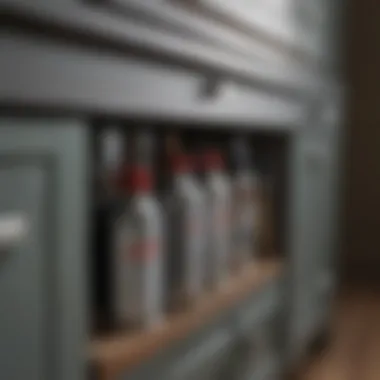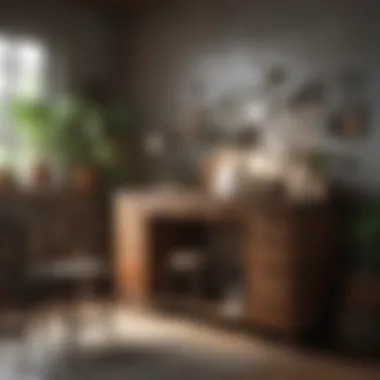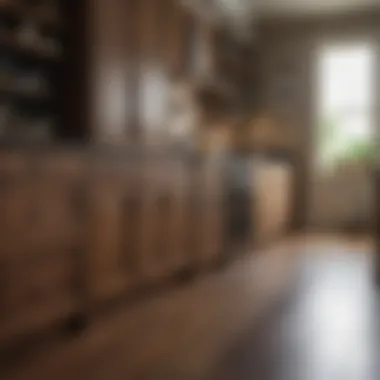The Intricacies of Cabinet Painting Explained


Intro
Painting cabinets presents a unique set of challenges and intricacies that can deter even the most enthusiastic DIYers. This task requires careful planning and execution to ensure a finish that is both aesthetically pleasing and durable. It is more than just applying paint; it involves understanding the material of the cabinets, choosing the right products, and preparing properly for the task at hand. This article seeks to illuminate the complexities involved and provide actionable insights for homeowners and DIY enthusiasts.
Preparing for the Job
Before diving into the world of cabinet painting, it is essential to prepare adequately. Preparation not only determines the overall outcome but also significantly impacts the time and effort involved in the project.
Assessing the Current Condition
Examine the existing cabinets. Check for any signs of damage such as scratches or water damage. Repairing these issues upfront can prevent further complications later. Look at the surface material as well, which affects how paint adheres.
Materials and Tools Selection
Choosing the right materials is critical for achieving lasting results. The following items are necessary components of cabinet painting:
- Primer: A high-quality primer is essential, as it ensures better adhesion.
- Paint: Select a durable paint specifically designed for cabinets. A popular choice is Sherwin-Williams’ ProClassic or Benjamin Moore’s Advance.
- Brushes and Rollers: Invest in high-quality brushes for smooth application.
- Sandpaper and Rags: Necessary for prepping the surface.
- Painter's Tape: Useful for protecting areas that should not be painted.
The Painting Process
Once the preparation is complete, the actual painting can begin. This process involves several steps to ensure a high-quality finish.
Proper Techniques
Begin by sanding the cabinets down to create a rough surface. This helps the primer to adhere better. After sanding, clean the surfaces thoroughly to remove dust or debris.
Apply primer and let it dry completely. It may require the application of two coats of primer, depending on the surface. Next, proceed with the chosen paint. Apply thin layers to avoid drips and achieve an even finish. Allow sufficient drying time between coats.
Common Pitfalls to Avoid
There are numerous pitfalls that a DIY enthusiast might encounter:
- Skipping the Primer: This can lead to chipping and peeling paint.
- Poor Sanding: Not sanding properly can result in a rough finish.
- Rushing: Taking shortcuts can compromise the longevity and aesthetic appeal of the job.
"Proper preparation and technique can save time and increase the enjoyment of your painting project."
Understanding Common Misconceptions
Several misconceptions surround painting cabinets that can lead to confusion:
- All Paints Are the Same: Not all paints are suitable for cabinets. Use products specified for high-use areas.
- It's Just Like Painting Walls: Cabinets require distinct techniques to ensure durability and a professional finish.
Being informed about the correct methods is essential for success.
The End
Painting cabinets involves a detailed approach that encompasses preparation, technique, and common misconceptions. By understanding the complexities and potential pitfalls involved, homeowners can equip themselves with knowledge to achieve remarkable results. The care taken in the initial steps will reflect throughout the project, making it worth the effort.
Preamble to Cabinet Painting
Cabinet painting is more than just a cosmetic change in a home. It transforms an often overlooked aspect into a focal point of any kitchen or space. The importance of understanding cabinet painting lies in the complexity of the task itself. Without awareness of the intricacies involved, one might take on more than they bargained for. This article aims to highlight those complexities, emphasizing the planning, tools, and techniques that play a significant role in the project’s outcome.
Many homeowners can experience great satisfaction by revitalizing old cabinets. However, without proper consideration of factors like paint selection and surface preparation, they may encounter frustrating challenges along the way.
Understanding the Appeal of Painted Cabinets


The appeal of painted cabinets is easily identifiable. First, they offer a fresh look at a lower cost compared to complete renovations. A simple color change can modernize a room, create a harmonious atmosphere, or even infuse a bit of personality into the home. Painted cabinets can also reflect trends or styles that align with the owner's design sensibilities.
Besides the aesthetic benefits, painted cabinets can enhance the perceived value of a home. Potential buyers often view updated kitchens favorably. This change can be a competitive advantage in the housing market, demonstrating care and attention in home maintenance. A well-executed cabinet paint job can create an inviting environment and form the centerpiece of culinary spaces.
Overview of Cabinet Painting as a DIY Project
Cabinet painting is often regarded as a popular DIY project. Many reasons contribute to this trend. For one, it allows individuals to save on labor costs associated with hiring professionals. DIY enthusiasts take pride in their ability to complete such tasks, creating a tangible sense of achievement.
However, just because it’s a DIY project does not imply that it is straightforward. Homeowners must plan meticulously. It begins with understanding the necessary tools, materials, and techniques. There are essential steps to prepare surfaces and choose the right type of paint, which can be daunting for first-timers.
Furthermore, the complexity increases when individuals consider their specific cabinet styles and the finish they prefer. Each aspect requires attention and care to ensure a desirable outcome.
In summary, while the transformation of cabinets via paint is appealing and possible, the complexities involved merit thorough exploration and consideration. Completing a cabinet painting project successfully requires more than just enthusiasm—it calls for planning and a keen understanding of the process.
Preparation Steps Before Painting
Preparing adequately before diving into a cabinet painting project cannot be overstated. This phase is crucial because it sets the foundation for a successful outcome. Proper preparation can prevent numerous headaches later, such as adhesion issues, uneven finishes, or even the need to redo the entire job.
Step one in this preparation process involves evaluating the current state of your cabinets. This means closely inspecting each cabinet's surfaces for signs of wear, damage, or mold. Understanding the existing condition allows you to determine how much work is needed and what repairs might be necessary before applying paint. This inspection phase is not just about spotting flaws; it helps you anticipate the demands of the project.
Once you understand the physical condition of your cabinets, you move on to gathering the necessary tools and materials. Without the right items, even the best-laid plans can fall flat. Key tools include quality brushes, rollers, painter's tape, and drop cloths. Materials might involve specific types of primer and paint tailored for cabinetry. It is advisable to choose high-quality products, as these can significantly impact the finished look and durability.
Next, surface cleaning and repair are imperative. All surfaces must be clean and free of grease, dirt, or previous finishes that could interfere with paint adhesion. A thorough cleaning might include degreasing agents or mild cleaners for tough spots. If you find cracks or chips, proper filling and sanding are essential to create a smooth surface for application.
In summary, the preparation steps before painting serve not only as a roadmap but as a vital part of the DIY cabinet painting process. By dedicating time to this phase, homeowners can greatly enhance the project's overall quality, creating cabinets that are aesthetically pleasing and long-lasting.
"Failing to prepare is preparing to fail." This saying rings true when it comes to painting cabinets.
Through careful attention to evaluation, tool selection, and surface preparation, the journey into transforming your cabinets can begin on a positive note.
Choosing the Right Paint
Choosing the right paint is not just a step in the cabinet painting process; it is crucial for the longevity and appearance of your cabinets. The complexity of this choice involves understanding the unique requirements of cabinetry, which can differ significantly from other surfaces like walls or furniture. Selecting the appropriate type can lead to enhanced durability, easier application, and a more appealing finish. Furthermore, picking the right paint can help avoid common pitfalls such as poor adhesion or uneven color distribution. Knowing what factors to consider can empower you to make informed decisions that align with your vision and budget.
Types of Paint for Cabinets
There are several types of paint suited for cabinets, each with distinct characteristics and benefits. The most commonly used types include:
- Oil-Based Paints: These provide a durable finish and have a rich color depth. However, they can take longer to dry and require solvents for clean-up. They are great for high-traffic areas.
- Water-Based Paints: Often preferred for their ease of use, these paints dry faster and clean up easily with soap and water. The finish can mimic oil-based products but may not provide the same level of durability.
- Acrylic Paints: Known for their quick drying time, acrylic paints also exhibit good adhesion. They are less toxic and have fewer fumes compared to oil-based varieties. This makes them suitable for indoor projects.
- Chalk Paints: This type offers a matte finish and is popular for achieving a vintage look. However, it often requires a sealant for protection against stains and damage.
Each paint type has its own pros and cons, so it’s essential to evaluate them based on your specific cabinet needs and your overall design goals.
Factors Influencing Paint Selection
Several factors will influence your paint selection. Evaluating these can simplify the decision-making process:
- Desired Finish: Whether you prefer a glossy, matte, or satin look will impact the paint choice. High gloss finishes are not only more durable but also easier to clean.
- Usage of the Area: Consider how much wear and tear your cabinets will undergo. If they are located in a high-traffic area, like a kitchen, opt for something robust.
- Climate Conditions: Humidity and temperature can affect drying times and paint performance. For areas with high humidity, opt for paints that provide moisture resistance.
- Environmental Considerations: If air quality is a concern, look for low-VOC (volatile organic compounds) options that minimize harmful emissions.
- Application Method: The way you plan to apply the paint (brush, roller, spray) can also dictate your paint choice, as some formulas work better with certain methods.
"The choice of paint can heavily influence not only the look but also the durability of your cabinets."
Making the right decision on the type and factors influencing paint selection will greatly enhance the outcome of your cabinet painting project.
The Painting Process
The painting process is pivotal in transforming cabinets and enhancing their overall appearance. Understanding its nuances allows homeowners and enthusiasts to achieve a professional look while adding value to their interiors. The process involves several key elements, including the methods of application, strategies for smooth finishes, and effective time management. Each aspect contributes significantly toward a satisfying outcome.
Key Techniques for Application


The application techniques used during the painting process can greatly influence the final result. Brush, roller, or spray techniques each have their specific benefits and drawbacks.
- Brush application offers control, especially in detailed areas. A high-quality synthetic bristle brush is essential for even distribution.
- Roller application covers larger flat surfaces quickly. This method is effective, but it may require additional touch-ups in corners.
- Spray painting provides a smooth application and uniform finish, ideal for intricate designs. However, it requires good ventilation and protective measures to avoid overspray.
Whichever technique chosen, practicing on a scrap piece of wood can help refine skill and technique before engaging the actual cabinets.
Achieving a Smooth Finish
Achieving a smooth finish is a primary goal in cabinet painting. This requires attention to detail. The prep work and paint selection play vital roles in this area. Here are some steps to consider:
- Use a high-quality primer. Primers like Zinsser Bulls Eye 1-2-3 can create a solid foundation.
- Apply thin coats of paint. Multiple thin layers work better than one thick layer. This reduces runs and drips, allowing for a more even finish.
- Sand between coats. Light sanding with fine-grit sandpaper helps smooth out imperfections and enhances adhesion.
A smooth finish not only improves the aesthetic appeal but also contributes to the durability of the cabinetry.
Time Management during the Project
Proper time management is essential for a successful painting project. Evaluating how long each step will take can prevent delays and frustrations. Here are some considerations for effective time management:
- Create a timeline. Set realistic deadlines for each phase, from preparation to the final inspection.
- Allow drying time. Each coat of paint needs sufficient drying time before applying the next. Rushing this can lead to imperfections.
- Plan for interruptions. Life can disrupt even the best-laid plans. Anticipate potential delays and adjust the timeline accordingly.
Adhering to these principles provides structure to the project and leads to a sense of accomplishment upon completion.
"Success in painting cabinets is not just about aesthetics; it requires careful planning, precision application, and a commitment to proper techniques."
Ultimately, understanding the painting process equips individuals with the knowledge necessary for undertaking this rewarding project.
Common Challenges Encountered
When engaging in the cabinet painting process, it is essential to understand the common challenges that can arise. This knowledge can vastly improve the outcomes of your project. Identifying potential issues early can help in effective planning and execution. From ensuring proper adhesion to managing drying times, each element plays a crucial role in achieving a satisfactory finish.
Issues with Adhesion and Chipping
One of the most frequent issues homeowners face when painting cabinets is poor adhesion between the paint and the cabinet surface. This problem can lead to chipping and peeling over time, ultimately compromising the durability of the paint job. Several factors can affect this, including:
- Surface Preparation: Failing to clean and prime surfaces properly can prevent the paint from adhering as intended. Cleaning removes dust and grease, while a primer can create a suitable base for paint application.
- Type of Paint: Not all paints adhere well to every surface. A high-quality paint designed specifically for cabinets will enhance adhesion.
- Environmental Factors: Humidity and temperature can impact the drying process, affecting adhesion negatively. Ideal conditions are crucial when painting.
By addressing these points, one can mitigate the risk of adhesion issues, leading to a more robust and aesthetically pleasing result.
Dealing with Uneven Coats
Achieving an even coat during the painting process can be quite a challenge. Uneven coats can result from several reasons, such as:
- Application Technique: Whether using a brush, roller, or sprayer, improper techniques can leave streaks or patches. It is advisable to learn the best methods for each tool to ensure uniform coverage.
- Multiple Coats: Applying too much paint at once can lead to runs and sags. A thin layer is usually more effective, allowing for better drying and leveling.
- Drying Times: Inconsistent drying times between coats can also cause variations. It is crucial to follow the recommended drying times of the specific paint used.
By paying attention to these aspects, one can achieve a more uniform finish, enhancing the overall appearance of the cabinets.
Navigating the Drying Time Dilemma
Drying time is another significant challenge in the painting process. Rushing the drying phase can lead to mistakes, such as smudging or sticking. Factors impacting drying time include:
- Type of Paint: Different paints have varied drying times. For example, water-based paints typically dry faster than oil-based alternatives. Checking manufacturer recommendations is essential.
- Environmental Conditions: Temperature and humidity levels greatly influence how quickly paint dries. Higher temperatures and lower humidity generally speed up the process, while the opposite can cause delays.
- Ventilation: Proper air circulation can expedite drying times. Ensuring an adequately ventilated area is essential when painting.
Understanding and managing these factors will lead to a more successful cabinet painting experience, reducing frustrations and ensuring quality results.
Remember, every painting project is unique. Being aware of these common challenges can empower you to adapt and find solutions effectively.
Finishing Touches


Finalizing a cabinet painting project is much more involved than simply applying a coat of paint. The finishing touches are crucial to ensure durability and aesthetic appeal. These steps can significantly impact the longevity of the finish and the overall look of the cabinets. Not paying attention to these aspects could lead to an unsatisfactory result, undermining the effort invested in the project.
Selecting Appropriate Sealants
Using the right sealant is an integral part of completing your cabinet painting project. Sealants offer a layer of protection, securing the paint against chips, scratches, and water damage. There are various options available, including water-based and oil-based sealants. Each has distinct qualities and applications.
- Water-Based Sealants: These tend to dry faster and have lower levels of volatile organic compounds (VOCs). They are ideal for light-colored paints, as they reduce the risk of yellowing over time.
- Oil-Based Sealants: Though they take longer to dry and require more ventilation, these sealants provide a durable finish that can withstand heavy use. They are suitable for darker colors and can enhance depth and richness.
When choosing a sealant, consider factors such as durability, drying time, and compatibility with your chosen paint. It's also important to follow the manufacturer's instructions on application for optimal results. A well-chosen sealant can extend the life of your cabinets and keep them looking fresh for years.
Final Inspection and Corrections
After the sealant has been applied and dried, performing a thorough inspection of the cabinets is paramount. Look for any imperfections or missed areas. Sometimes, minor flaws can go unnoticed until the final stage.
Conducting your final inspection involves:
- Checking for Imperfections: Look for any uneven edges, drips, or bubbles in the paint.
- Assessing the Sealant Application: Ensure that the sealant coverage is consistent and that there are no missed spots.
- Making Corrections: If any issues are found, they should be addressed immediately. This might involve light sanding and reapplying paint or sealant to ensure a uniform appearance.
Pay attention to the hardware as well. Install knobs or handles carefully to not damage the newly painted surfaces, which can often be a common oversight.
"The finishing touches not only enhance the visual appeal, but they also play a critical role in maintaining your cabinets' integrity over time."
Maintaining Painted Cabinets
Maintaining painted cabinets is essential to preserving their appearance and longevity. Over time, painted surfaces can suffer from wear and tear due to everyday use and environmental factors. Proper maintenance ensures that the investment made in painting cabinets is not compromised by neglect. A structured approach to care can help in retaining the beauty of the cabinets while preventing costly repairs or repainting.
Routine Care and Cleaning
Regular cleaning is a fundamental aspect of maintaining painted cabinets. It is recommended to use a soft cloth and a mild soapy solution to wipe down surfaces. This can help remove dirt, grease, and fingerprints. Avoid abrasive cleaners that can scratch and damage the paint finish.
Here are some specific tips:
- Dust weekly using a microfiber cloth.
- Use gentle cleaning agents that are free from harsh chemicals.
- Rinse surfaces after using soap to prevent residue build-up.
- Dry thoroughly to prevent moisture spots.
In addition, maintaining cabinet hardware is important. Regularly check hinges and knobs for looseness or damage. Grease or silicone spray can be applied to moving parts to ensure smooth operation.
Identifying Issues Early
Regular inspections of painted cabinets will help in spotting any issues before they escalate. Look for cracks, chips, or discoloration in the paint. If these problems are identified early, they can often be repaired with minimal effort.
Signs to watch for include:
- Signs of water damage, such as swelling or bubbling of the paint.
- Fading, which can occur from exposure to sunlight.
- Any peeling, which may indicate poor adhesion.
Timely intervention can save both time and money. If detected early, touch-ups can be done to enhance the cabinets' aesthetic appeal. By addressing these concerns promptly, homeowners can ensure their painted cabinets maintain their original charm and functionality.
Maintaining painted cabinets is not just about keeping them clean; it involves proactive measures to ensure long-lasting beauty and durability.
End
The conclusion signifies the culmination of the discourse on cabinet painting. It is not just the end but a vital reflection on all elements explored in the article. Each stage of the process has its unique challenges and rewards. Understanding these intricacies is essential for anyone considering this project.
Recap of Essential Considerations
To reiterate the key points discussed:
- Preparation is Crucial: Proper assessment of the cabinets and selection of necessary tools and materials ensure a solid foundation. This step directly influences the quality of the finished product.
- Choosing the Right Paint: The type of paint and the reasoning behind its selection matters significantly. Factors like durability, finish, and color selection should not be overlooked.
- Application Techniques: Employing the correct painting methods can eliminate common issues, such as uneven coats or chipping.
- Finishing Touches: The choice of sealants and thorough inspection after the painting can significantly increase the lifespan and aesthetics of the cabinets.
- Ongoing Maintenance: Finally, understanding routine care for painted cabinets ensures that the work done continues to impress over time.
Final Thoughts on Cabinet Painting
Cabinet painting can be a rewarding journey, transforming a space while showcasing craftsmanship and creativity. For DIY enthusiasts, this project holds both learning experiences and aesthetic satisfaction. Careful consideration of each aspect outlined in the article helps mitigate risks and enhance desired outcomes.
Whether one is a homeowner looking to refresh their kitchen or an interior design enthusiast aiming to elevate their space, the finesse in painting cabinets is achievable. Success in cabinet painting lies not only in the technical skills but also in the careful judgment of choices made throughout the process. With diligence and an eye for detail, beautiful cabinets are within reach.







